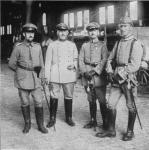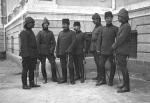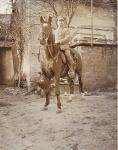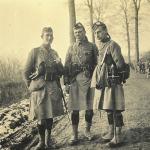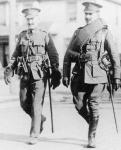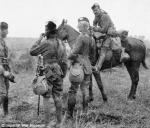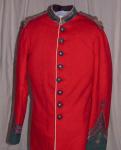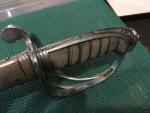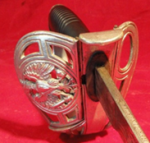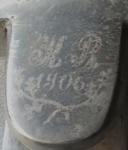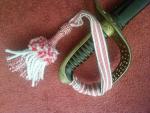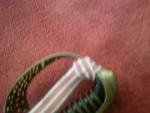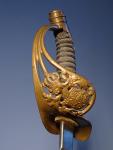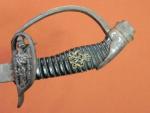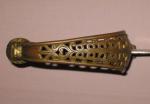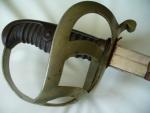-
Posts
563 -
Joined
-
Last visited
Content Type
Profiles
Forums
Blogs
Gallery
Events
Store
Everything posted by aussiesoldier
-
“Mad Jack Churchill†carried a sword into battle in WW2! Lieutenant Colonel John Malcolm Thorpe Fleming "Jack" Churchill, DSO & Bar, MC & Bar, nicknamed Fighting Jack Churchill and Mad Jack, was a British soldier who fought throughout the Second World War armed with a longbow, bagpipes, and a basket-hilted Scottish broadsword. He is known for the motto "any officer who goes into action without his sword is improperly dressed."
-
Swords withdrawn from most of the cavalry in 1915 By the beginning of 1915 with the solidifying of the trench system, they could no longer find employment on the Western Front. II and IV Cavalry Corps were dissolved and I and III Cavalry Corps were transferred to the East. With less use as pure Cavalry formations, each underwent a series of re-designations according to their particular role from time to time. The dismounted divisions were converted to Cavalry Schützen Divisions. Here, the cavalry brigades were renamed Cavalry Schützen Commands and performed a similar role to that of an infantry regiment command. Likewise, the cavalry regiments became Cavalry Schützen Regiments and alloted the role of an infantry battalion and their squadrons acted as infantry companies. I can't find a photo of cavalry on the Western Front after 1916 that shows a German cavalryman with KD89 attached to the horse saddle. Basic equipment by then seems to have been lance and carbine. However, many images of officers behind the lines still wearing their swords.
-
Gentlemen, I posted on the German Edged Weapons site photographs of WW1 1889 Infantry swords. There is nothing to say that they were not carried into battle in 1914. Indeed, I have a photograph of a British officer during the retreat from Mons armed with a 1897 Infantry sword and a group of German officers in Brussels armed with a variet of swords including 1889 infantry and the 1855 Bavarian sword. Fearful of the attention the sword brought from snipers and the impractically of wearing a sword in the trenches, it seems they were put away once the Western Front settled into trench warfare. NOTE. Montgomery carried his sword into battle in the opening months of the war. There are also a large number of German Artillery swords of the modified Blucher design on the market and in collections. Mine is dated 1916. I have a photo of a German artillerymen beside his horse, sword fitted to saddle and another of the 'postman' on his horse, sword fitted. I'll do what I can to post some of them on the edged weapon site and on here. George
-
Maa'aate, We shouldn't be too tough on the Brits either. The River Clyde experiment at Cape Helles was worth a try. People forget that this was the first real attempt to land on a hostile shore for almost two thousand years. Yes, Julius Caesar and Emperor Claudius got ashore, but there is a slight difference between Celts with swords and Turks with Maxim machine guns.
-
Being Australian, 2015 will focus upon the Gallipoli campaign. Happily, it has kicked off with what looks like a historically correct version of the landing at Anzac. Ashmead Bartlett NEVER landed at Anzac yet managed to get his imaginative rendition of 'shot and shell' published and popularised around Australia and in the minds of thousands of school children. CEW Bean landed four hours after sunrise and consistently corrected the record and said the landing was relatively unopposed. The new TV series "Gallipoli" has told this version. I am always amazed that Australians regard the landing as a shambles. All modern research indicates we landed where Birdwood and Bridges wanted the troops. Fisherman's Hut would have been a slaughterhouse. They choose this cove because you wouldn't send a dog up it and the Turks had it very lightly defended. Birdwood, quite rightly for a Brit., fully understood the nature of his 'colonial' Anzac's and knew they could conquer anything. How close? If the leading elements had been reinforced and provided with ammunition, they would have seized the Vital Ground that dominated the strait and the peninsula. The campaign would have been over on the night of the first day. Sadly, the turning point was the arrival of Mustafa Kemal who made his men fix bayonets and take up firing positions even though they had no ammunition. He reasoned that the Anzacs would go to ground and they did. The momentum was lost. Kemal's regiment arrived and the campaign was lost. An excellent program to watch is "Gallipoli from the Air". Explains all of the work put into selecting Anzac Cove. Also the Australian War Memorial magazine, War Cry, had a series of articles that provided proof of this planning. I look forward to the truth finally being told. Not a disaster and poor planning but a bold gamble with risks calculated fully in keeping with the spirit and elan that typified the Anzacs in WW1.
-
Gentlemen, Apart from the fact that the beaches on the Central Coast of NSW are the world's best . . . If the sacks contained grain, etc. Could they not have been designed to transport fodder and feed for horses. The Wehrmacht relied very heavily upon horses for transport for much of WW2. Just a point from sunny NSW, Australia! PS When in Cadets we were issued sacks like this and put hay in them as palliasse mattress
-
Major George Stack's RNSWR was born on the 12th March 1846 in Maitland. He began work as a civil engineer in the NSW Government Architect's Office. As a young man , in 1860, he joined the Balmain Volunteer Rifle Company . He was commissioned as Second Lieutenant in the Second Regiment, New South Wales Volunteer Infantry on 17th May 1871 and Lieutenant on the 17th August 1876. He retired January, 1894 and was made Honorary Major, receiving the Volunteer Officer's Decoration. This uniform was manufactured by David Jones the oldest department store in the world which has traded under the same name since commencement of business.The garment is sewn completely by hand. The Regimental uniform was at first rifle green with black stripes along the outer seams one and a half inches in width. White trousers were worn in summer.In 1869, during the Maori War in New Zealand, enthusiasm in the Regiment was revived as a result of public meetings and under the new title of "The Sydney Battalion" a considerable number of recruits were enlisted. At this time a change in the uniform was made, the newly adopted dress being grey with black facings, and an infantry shako and brown belt. Another change was made to the uniform the following year, when scarlet tunics, dark blue trousers with scarlet piping were adopted. The shako was retained but some years later was replaced with a white helmet.
-
Thanks Mervyn, Even if it is just a display piece, it helps fill out my collection in an interesting way. I have read some of the pitfalls of removing chrome and I hesitate on this. The guard has certainly not been chromed - perhaps the blade remained in the scabbard uncared for too long. I have ordered Ballistol oil on the recommendation of Sword Forum. Thanks for the info. 1st Battalion (City of Sydney's Own) RNSWR and the 2nd Battalion was an outer suburban regiment but became the 2nd Battalion (City of Newcastle's Own) RNSWR. The old Regiment disbanded in 1860 and a much larger regiment of 2,000 rifles was raised in its place. The unit was re-titled the First Regiment NSW Rifle Volunteers, known as the Sydney Battalion. The withdrawal of the British Garrison in 1870 led to a rapid increase in the size of the regiment, to 2,382. Red tunics were adopted in the Sydney Battalion to replace the grey, making the regiment smarter and more soldier-like in appearance. In 1885, the colonists urged the Government of NSW to send a contingent to the Soudan to serve Queen and Empire. 734 men were dispatched, 74 of whom came from the First Regiment. This was named the New South Wales Soudan Contingent and was Australia's first fighting force to serve in an overseas campaign. With the outbreak of the Boer War in 1898 patriotism again ran high and the Regiment sent 103 of its rank and file to assist "Queen and Empire". With Federation in 1901 the Regiment became part of the Commonwealth Military Forces redesignated the First Australian Infantry Battalion Royal New South Wales Regiment City of Sydney's own. I will make a second entry on some uniform photographs including some detail of Major George Stack's uniforms.
-
The Royal NSW Regt traces its heritage back to the oldest infantry battalion from New South Wales and is a successor unit of the Sydney Volunteer Rifles which were raised in 1854 in the then colony of New South Wales in response concerns about possible threats posed by Russian naval forces in the Pacific during the Crimean War. Following that the unit went through a number of changes in composition and designation as the various colonial defence forces were reorganised during the mid to late 19th Century. By 1860 the unit had become known as the "Sydney Battalion", but in 1878 following the decision to introduce a system of partial payment for volunteer soldiers, the unit was absorbed into the 1st Regiment of New South Wales Volunteer Infantry. In 1885, the 1st Regiment provided a detachment of one officer and 75 men to serve in Sudan during the Mahdist War, for which they received the battle honour "Suakin 1885". During the Second Boer War 12 officers and 91 men from the regiment served in South Africa as part of the New South Wales contingent, for which they were later recognised with the battle honour of "South Africa 1899–1902". Following Federation the regiment became the 1st Australian Infantry Regiment. One can't help but think that the sword dates back to the very origins of the 1st Regiment of New South Wales Volunteer Infantry.
-
Can't say I care if it is unique but it is damned unusual - I have not seen another! Just love this sword and a great balance to my 1897 Infantry sword with Royal Marine crest. 1854 Infantry sword, probably 1860's/70's with the blade and scabbard chromed. Proved plug indicates a Thurkle sword but no obvious makers mark - lost in the chroming. Remains of the VR cypher and crown. Regimental badge added = Royal New South Wales Regiment. I served with 2/17 Battalion, RNSWR in the 1970's.
-
-
Hi gents, I had need of fitting a company officer's tassel (the type illustrated) to our family war relic Type 98. The only one I could afford was a repo and it looks great.You'll notice from the photo that I changed the ties at the end. I found a website that showed this method as the proper way to tie the tassel off, but I frequently see them tied your way in period photographs. Go figure. Dad aquired the sword from a Japanese officer who no longer needed it at Buna in 1942. He had already faced down a French Foreign Legion cavalry charge in Lebenon, and fought the advance over Kokoda. The battalion went from over 800 at Port Moresby to under 250 standing at Buna. Malaria was the major problem although dad got malaria and Japanese shrapnel as a keepsake. PS The only original tassels I have seen are very expensive. Ebay has a lot labelled original but almost certainly repo. George
-
A number of the 1889 Infantry swords that have been etched as a gift to a retiring officer or in one case I have seen, as a prize for the best shot in a competition, but they seem to have are always of a combat weight sword that is etched/engraved. Interestingly enough, I have seen a Wurttemburg 1889 Kavallerie sword that had issue numbers and was not etched as a presentation sword but had a solid guard. The blades of the three presentation KD89 I have vary in quality and weight so but almost always have a folding guard. Officers were transferred between regiments so never purchased these presentationn swords using instead a lion head saber. None of my artillery swords are strong enough for combat but I almost bought a Blucher blade that had been elaborately etched. http://gmic.co.uk/uploads/monthly_01_2015/post-17938-0-11719400-1421452071.pnghttp://gmic.co.uk/uploads/monthly_01_2015/post-17938-0-32486700-1421452103.jpghttp://gmic.co.uk/uploads/monthly_01_2015/post-17938-0-80837900-1421452115.png Maker marked = JOH KRUGER, LUNEBURG. Owner’s name engraved on bottom of guard = GEFR BONIG. (The rank of Gefreite was considered in English the equivalent to a British Army Lance Corporal rank.) On mobilization on 2 August 1914 the IX Corps was restructured. The 16th (2nd Hannover) Dragoons formed two half-regiments which were assigned as divisional cavalry to 17th and 18th Divisions of IX Corps. On mobilisation, IX Corps was assigned to the 1st Army on the right wing of the forces for the Schlieffen Plan offensive in August 1914 on the Western Front. It participated in the Battle of Mons and the First Battle of the Marne which marked the end of the German advances in 1914. Later it saw action in the Battle of Pozières and Battle of Amiens (1918). It was still in existence at the end of the war.
-
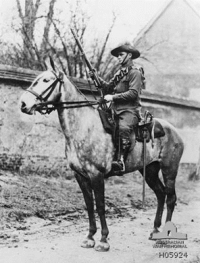
Collecting Imperial German Artillery Regiments
aussiesoldier commented on IrishGunner's blog entry in Imperial German Artillery Regiments
Images for 4th (Magdeburg) Field Artillery "Prince Regent Luitpold of Bavaria" “Ginj.Freiw.D.Nebelungâ€, Ginj. Freiwilliger der Nebelung = Ginj . Volunteer of the Nebelung -
19th (1st Thuringian) Field Artillery Raised from a catchment area that included the newly annexed Province of Hesse-Nassau and the Thuringian principalities (Saxe-Weimar, Saxe-Meiningen, Saxe-Coburg and Gotha and Waldeck). The XI Corps was assigned to the VI Army Inspectorate but joined the predominantly Saxon 3rd Army at the start of the First World War. The regiment joined the predominantly Saxon 3rd Army at the start of the First World War forming part of the right wing of the forces for the Schlieffen Plan offensive in August 1914 on the Western Front. It participated in the capture of Namur and was immediately transferred to the Eastern Front to join the 8th Army in time to participate in the First Battle of the Masurian Lakes. It was then transferred to the 9th Army and took part in the Battle of the Vistula River. It returned to the Western Frond at the end of 1915. It was still in existence at the end of the war in the 6th Army, Heeresgruppe Kronprinz Rupprecht on the Western Front. http://gmic.co.uk/uploads/monthly_01_2015/post-17938-0-94294200-1421275844.jpghttp://gmic.co.uk/uploads/monthly_01_2015/post-17938-0-68735100-1421275863.jpghttp://gmic.co.uk/uploads/monthly_01_2015/post-17938-0-11903100-1421275879.jpghttp://gmic.co.uk/uploads/monthly_01_2015/post-17938-0-13243100-1421275928.jpg http://gmic.co.uk/uploads/monthly_01_2015/post-17938-0-49854300-1421275940.jpghttp://gmic.co.uk/uploads/monthly_01_2015/post-17938-0-83235900-1421275945.jpg
-
PRESENTATION ARTILLERY SWORDS IV Corps (German Empire) 7th Field Artillery Brigade; 4th (Magdeburg) Field Artillery Regiment The IV Army Corps was a corps level command of the Prussian and then the Imperial German Armies from the 19th Century to World War I. It was established on 3 October 1815 as the General Command in the Duchy of Saxony and became the IV Army Corps on August 30, 1818. Its headquarters was in Magdeburg and its catchment area included the Prussian Province of Saxony and the adjacent Saxon Duchies and Principalities. In peacetime, the Corps was assigned to the VI Army Inspectorate but joined the 1st Army at the start of the First World War. It was still in existence at the end of the war in the 6th Army, Heeresgruppe Kronprinz Rupprecht on the Western Front. The Corps was disbanded with the demobilisation of the German Army after World War I. http://gmic.co.uk/uploads/monthly_01_2015/post-17938-0-40243700-1421275371.jpghttp://gmic.co.uk/uploads/monthly_01_2015/post-17938-0-34254800-1421275388.jpghttp://gmic.co.uk/uploads/monthly_01_2015/post-17938-0-29235400-1421275406.jpg I think #3 translates as “Ginj.Freiw.D.Nebelungâ€, Ginj. Freiwilliger der Nebelung = Ginj . Volunteer of the Nebelung
-

Collecting Imperial German Artillery Regiments
aussiesoldier commented on IrishGunner's blog entry in Imperial German Artillery Regiments
4th (Magdeburg) Field Artillery Regiment "Prince Regent Luitpold of Bavaria" IV Corps (German Empire) 7th Field Artillery Brigade; 4th (Magdeburg) Field Artillery Regiment The IV Army Corps was a corps level command of the Prussian and then the Imperial German Armies from the 19th Century to World War I. It was established on 3 October 1815 as the General Command in the Duchy of Saxony and became the IV Army Corps on August 30, 1818. Its headquarters was in Magdeburg and its catchment area included the Prussian Province of Saxony and the adjacent Saxon Duchies and Principalities. In peacetime, the Corps was assigned to the VI Army Inspectorate but joined the 1st Army at the start of the First World War. It was still in existence at the end of the war in the 6th Army, Heeresgruppe Kronprinz Rupprecht on the Western Front. The Corps was disbanded with the demobilisation of the German Army after World War I. -
There is every chance, considering the Garde badge on the hilt, that your sword belonged to the Leibgarde-Infanterie-Regiment (1. Großherzoglich Hessisches) Nr. 115, of the 49. Infanterie-Brigade (1. Großherzoglich Hessische), part of the 25th Division in 1914, shortly before the outbreak of World War I.
-
I could not afford to buy one of the very rare Hessian Portepee so I have attached a Hessian Faustriemen or Troddel (never really been able to work out the difference but the later seems to be what is usually used). The only logical place is to loop it around the neck of the guard. I am open to alternatives but the two loop holes on the quillon don't seem logical nor practical. Rightly or wrong I have sought to attach something to all of my swords, if only to add to their display appeal. http://gmic.co.uk/uploads/monthly_01_2015/post-17938-0-20261800-1421200844.jpeg http://gmic.co.uk/uploads/monthly_01_2015/post-17938-0-86220300-1421200917.jpeg
-
Two of my 1889 Infantry Degen The Infanterie-Degen M1889 was introduced into service as the standard issue sword for all Infantry troops in the armies of the German Empire (Prussian, Saxon, Bavarian and Wurttemberg). The various states inset their own coat of arms into the half basket guard to differentiate their own regiments, in this case the Wurttemburg crest, or as a folding guard, in this case the Prussian Eagle crest, but the sword profiles were identical. The Model 1889 Officer's Degen was in service from about 1906 to about the end of WWI. The twin fullered blade was designed for thrusting in line with the common wisdom of the time, which stated that ‘the point will always beat the edge’. Officers tended to purchase their own sword and their weapons were often ornamented and differed in quality according to price. Blade measures 32 1/8", Sword measures 38 Scabbard measures 38 7/8". http://gmic.co.uk/uploads/monthly_01_2015/post-17938-0-74342200-1421194875.jpg http://gmic.co.uk/uploads/monthly_01_2015/post-17938-0-67951400-1421194913.jpg
-
WWI issue German sword from the state of Hesse. This is a model 1854 Infantry Officers sword that is an army issue piece. In Cut and Thrust Weapons by Eduard Wagner, this pattern was carried by the officers of the 116th - 118th Hessian infantry regiments. The blade is essentially the same blade as the M1855 Bavarian Infantry sword. Each German State had their own patterns of infantry swords prior to the introduction of the Infanterie-Degen M.1889 which was the first standard issue infantry sword for infantry troops in the armies of the German Empire. Despite the introduction of the Infanterie-Degen M.1889, older pattern swords remained in service up to and throughout WW1. The guard design is what makes the Hessian Infantry sword stand out.This one is mine. http://gmic.co.uk/uploads/monthly_01_2015/post-17938-0-26238800-1421185277.jpghttp://gmic.co.uk/uploads/monthly_01_2015/post-17938-0-31023100-1421185305.jpg
-
KD52 TROOPER'S PRESENTATION SWORD Each German State had their own patterns of cavalry swords prior to the introduction of the Preußischer M.1852 Kavallerie-Degen. This was the issue sabre until the Kavallrie Degen Mod 1889, then these were passed to secondary and support units. This weapon was issued in the Prussian Army from 1852 to 1918 and was as the standard issue sword for all Hussar,Ulan and Dragoon regiments in the Prussian Army, between 1857 and 1889. Preußischer M.1852 Kavallerie-Degen Despite the introduction of the KD89, older pattern swords remained in service up to and throughout WW1, and the M.1852, which was a much heavier cutting weapon than the KD89. This is a trooper’s presentation sword as was assembled by, W Damke, Magdeburg . At the time of Frederick the Great logistics materials, including food, were stored in so-called (logistics) Train depot / or armouries. These were all managed by the supply dump. Each regiment and battalion ran his own (logistics) train with it. From this later group was formed independent Train columns, these included field bakeries, food columns and hospitals. Between 1807 and 1914 20 of these neupreußischen Train battalions were established as part of the new military organization. The Magdeburgische Train Battalion No. 4 was the Train Battalion of the IV Army Corps of the Prussian army. On mobilisation, IV Corps was assigned to the 1st Army on the right wing of the forces for the Schlieffen Plan offensive in August 1914 on the Western Front. It participated in the Battle of Mons and the First Battle of the Marne which marked the end of the German advances in 1914. Later, it participated in the Battle of the Somme, particularly the Battle of Delville Wood and the Battle of Pozières. It was still in existence at the end of the war in the 6th Army, Heeresgruppe Kronprinz Rupprecht on the Western Front. http://gmic.co.uk/uploads/monthly_01_2015/post-17938-0-12930700-1420770876.jpghttp://gmic.co.uk/uploads/monthly_01_2015/post-17938-0-12514600-1420770914.jpg http://gmic.co.uk/uploads/monthly_01_2015/post-17938-0-10359600-1420770946.pnghttp://gmic.co.uk/uploads/monthly_01_2015/post-17938-0-28831800-1420770967.jpg


